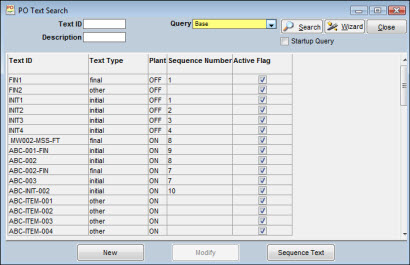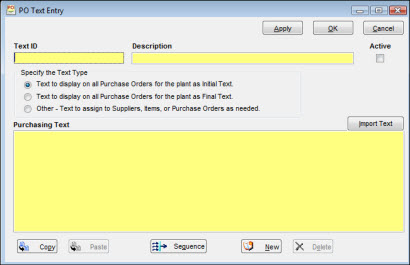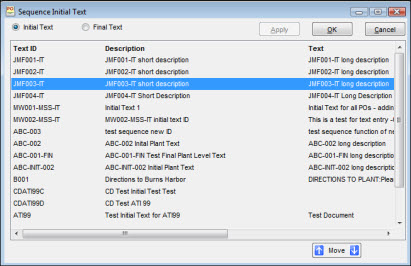|
|
|
|
|
|
Text copy functionality makes purchase order creation easier. The Purchase Order Text Library provides you with a repository of standard text that buyers can manage and select to build blanket orders and standard orders. This feature allows text to be associated at the plant, supplier, and item levels.
From the TabWare Setup module, access the Purchasing Setup Options window. Select the checkbox Use PO Text Library to enable the Purchase Order Text Library feature. Access to the various windows related to the text library can be managed through Security. The Purchase Order Text Entry window controls text library setup and is located in Security for the Purchasing module. Access to this window, along with the Purchase Order Text Search and Purchase Order Text Sequence windows, should be granted to anyone responsible for managing the library.
This window is a query wizard for searching the Purchasing Text entries entered in the Purchasing Text Definition window. The Text Search window is accessed from the Go To button in the Purchase Order Search window. The fields available for display and search are:
Text ID
Text Description
Block of Text
Sequence Number
Text Type – initial, final, or other
Active Flag
Entered By
Entered Date
Last Modified By
Last Modified Date

There are three buttons at the bottom of the Text Search window:
Opens the Purchasing Text Entry/Update window in New mode for entry of a new Text ID.
Opens the Purchasing Text Entry/Update window for the selected row(s).
Opens the window for sequencing text.
This window is accessed from the Text Search window and is used for entry of standard purchasing text.

To Create a Text Entry:
|
1. |
Click the New button at the bottom of the PO Text Search window and enter a Text ID and a 40-character description of the text. Specify the type of text:
|
|
2. |
Enter the block of text in the bottom portion of the window. By clicking the Import button, the contents of a text file can be copied (the Import button copies only from files with extension .txt). |
A Text ID can be flagged as active by selecting the Active checkbox. A Text ID can be inactivated at any time by deselecting the checkbox. When the Active checkbox is unchecked, the system will display a warning message if the Text ID is assigned to any active supplier, item, or open purchase order. Once inactivated, the Text ID will not be available for future assignment to a supplier, item, or purchase order.
Once a Text ID has been assigned to a purchase order, the text verbiage is protected and can no longer be updated. This restriction is necessary so that old purchase orders can be accurately reprinted. If text verbiage needs to be updated following assignment of the Text ID to purchase orders, a new Text ID should be created. You can cut and paste the text from the original Text ID, modify as needed, and then mark the original Text ID as inactive.
A Text ID can be deleted using the Delete button. A Text ID cannot be deleted if it has been assigned to any supplier, item, or purchase order.
For each Text ID, TabWare will record the ID of the person creating the Text ID, date created, date last changed, and the ID of the person who made the last change. This information can be displayed on the Purchasing Text Search window.
The Sequence button opens a new window for setting the display order of initial and final comments. This button is enabled only if the current Text ID displayed is flagged as either Initial or Final Text; if the Text ID being displayed is flagged as Other, the Sequence button is disabled.

The Sequence Text window is used to sequence text blocks flagged for display on all purchase orders as Initial or Final Text. This window is opened from the PO Text Search window by clicking the Sequence Text button. The Sequence Text window can also be opened from the Purchasing Text Entry/Update window by clicking the Sequence button. If the current Text ID displayed on the Entry/Update window is flagged as Initial Text, then the Sequence Text window is opened showing all active Text IDs flagged as Initial, in the order specified by the current sequence. If the current Text ID displayed on the Entry/Update window is flagged as Final Text, then the Sequence Text window is opened showing all active Text IDs flagged as Final, in the order specified by the current sequence.
The Sequence Text window displays the Text ID, the 40-character Description, and the first 100 characters of the Text.
To Sequence Text:
|
1. |
Select the Text ID to move and click the Move Up/Down arrows to sequence the text block in the desired order. |
|
2. |
When finished, click OK or Apply. Clicking OK closes the window. Clicking Apply updates the database with the new sequence without closing the window. |
The steps for sequencing Final Text are the same as those for sequencing Initial Text.
When the purchase order prints, the Initial Text section is printed as follows:
Any lines of Initial Text entered using the button on the first tab of the PO Notebook print.
Next, the blocks of Initial Text listed on the Initial Text tab print in the same order as displayed on the tab.
As the PO lines are printed, the item descriptions are printed as follows:
The extended description of the item is printed.
Next, the blocks of Item Text listed on the new tab for item-level text codes are printed.
At the end of the purchase order, the Final Text section is printed as follows:
Any lines of Final Text entered using the button on the first tab of the PO Notebook print.
Next, the blocks of Final Text listed on the Final Text tab print in the same order as displayed on the tab.